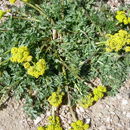Comprehensive Description
provided by North American Flora
Lomatium circumdatum (S. Wats.) Coult. & Rose, Contr. U. S Nat. Herb. 7: 213. 1900.
Peucedanum circumdatum S. Wats. Proc. Am. Acad. 22: 474. 1887. Cogswellia circumdata M. E. Jones, Contr. W. Bot. 12: 33. 1908.
Plants caulescent, 1.5-3.5 dm. high, from an elongate to subglobose tuber, glabrous to somewhat pubescent; leaves broadly oblong in general outline, excluding the petioles 5-6 cm. long, ternate, then 1-2-pinnate, the ultimate divisions distinct, linear, 6-10 mm. long, 1-2 mm. broad, apiculate; petioles 3-6 cm. long, those of the cauline leaves wholly scarious-sheathing ; peduncles exceeding the leaves; involucel of conspicuous, obovate, acute, prominently nerved, sometimes connate bractlets, much longer than the flowers; rays 7-12, ascending, 2-8 cm. long; pedicels 2-3 mm. long, the umbellets many-flowered; fruit oblong, 6-9 mm. long, 3-4 mm. broad, glabrous, the wings much narrower than the body; oil-tubes solitary in the intervals, 4 on the commissure. Type locality: "Abundant on hillsides in the Wallowa region of eastern Oregon," Cusick. Distribution: Western Idaho to adjacent Washington, southeastern Oregon, and northeastern Nevada (Heller &• Heller 4043, Sandberg, MacDougal &■ Leiberg 21).
- bibliographic citation
- Albert Charles Smith, Mildred Esther Mathias, Lincoln Constance, Harold William Rickett. 1944-1945. UMBELLALES and CORNALES. North American flora. vol 28B. New York Botanical Garden, New York, NY
Comprehensive Description
provided by North American Flora
Lomatium cous (S. Wats.) Coult. & Rose, Contr. U. S. Nat Herb. 7:214. 1900.
Peucedanum Cous S. Wats. Proc. Am. Acad. 21: 453. 1886. Cogswellia Cous M. E. Jones, Contr. W. Bot. 12: 33. 1908.
Plants acaulescent or short-caulescent, 2-2.5 dm. high, from a globose, sometimes elongate tuber; leaves oblong to obovate in general outline, excluding the petioles 5.5-9.5 cm. long, usually glabrous, ternate, then 2-3-pirmate or pinnately decompound, the ultimate divisions crowded, ovate to oblong, 1-5 mm. long, 1-2 mm. broad, mucronulate; petioles 3-6 cm. long, sheathing to above the middle; peduncles exceeding the leaves, scaberulous; involucel of oblanceolate, shortly connate bractlets, about equaling the flowers; rays 10-20, spreading, 1-5 cm. long, unequal; pedicels 2-4 mm. long, the umbellets about 20-flowered; flowers yellow; fruit oblong-oval, 7-10 mm. long, 3-5 mm. broad, granular-roughened, the wings narrower than the body; oil-tubes usually solitary in the intervals, 4 on the commissure.
Type locality: "John Day's Valley, eastern Oregon," Howell 270.
Distribution: Western Idaho to southeastern Washington and central Oregon (Cusick 1837, Heller &■ Heller 3052).
- bibliographic citation
- Albert Charles Smith, Mildred Esther Mathias, Lincoln Constance, Harold William Rickett. 1944-1945. UMBELLALES and CORNALES. North American flora. vol 28B. New York Botanical Garden, New York, NY
Comprehensive Description
provided by North American Flora
Lomatium montanum Coult. & Rose, Contr. U. S. Nat. Herb. 7: 214. 1900.
Lomatium purpureum A. Nelson, Bull. Torrey Club 28: 226. 1901. Peucedanum montanum Blankinship, Mont. Agr. Coll. Stud. 1: 93. 1905. Cogswellia montana M. E. Jones, Contr. W. Bot. 12: 34. 1908.
Plants acaulescent, 1-3 dm. high, cespitose from a thickened taproot or a subglobose tuber, glabrous; leaves usually oblong in general outline, excluding the petioles 2.5-12 cm. long, ternate, then 2-3-pinnate, the ultimate divisions crowded, oblong, 2-10 mm. long, 0.5-3 mm. broad, apiculate; petioles 1.5-7 cm. long, sheathing to above the middle, purplish; peduncles exceeding the leaves; involucel of conspicuous, obovate, purplish bractlets, distinct or united below; rays 5-15, spreading, 1-6.5 cm. long, unequal; pedicels 2-3 mm. long, the umbellets about 20-flowered; flowers yellow; fruit oval-oblong, 5-12 mm. long, 3-5 mm. broad, the wings narrower than or about equaling the body; oil-tubes 2-4 in the intervals, 6 on the commissure.
Type locality: "Mountain ridges in Yellowstone National Park," Rose 479. Distribution : Western Montana and Wyoming to northern Idaho and eastern Oregon (Blankin-
- bibliographic citation
- Albert Charles Smith, Mildred Esther Mathias, Lincoln Constance, Harold William Rickett. 1944-1945. UMBELLALES and CORNALES. North American flora. vol 28B. New York Botanical Garden, New York, NY
Lomatium cous
provided by wikipedia EN
Lomatium cous (cous biscuitroot)[1] is a perennial herb of the family Apiaceae. The root is prized as a food by the tribes of the southern plateau of the Pacific Northwest. Meriwether Lewis collected a specimen in 1806 while on his expedition.[2]
It is called x̣áwš in the Sahaptin language, and qáamsit (when fresh) and qáaws (when peeled and dried) in the Nez Perce language.
It is called shappelell by the Chinooks: "... and a kind of bisquit, which the natives make of roots called by them shappelell." -- Meriwether Lewis, Friday, January 9th, 1806. From The Definitive Journals of Lewis & Clark, Down the Columbia to Fort Clatsop. Volume 6 of the Nebraska Edition. Gary E. Moulton, Editor. University of Nebraska Press, Lincoln, 1990.
References
-
^ USDA, NRCS (n.d.). "Lomatium cous". The PLANTS Database (plants.usda.gov). Greensboro, North Carolina: National Plant Data Team. Retrieved 23 June 2015.
-
^ Schiemann, Donald Anthony. Wildflowers of Montana, page 174. Mountain Press Publishing Company, Missoula, 2005.

- license
- cc-by-sa-3.0
- copyright
- Wikipedia authors and editors
Lomatium cous: Brief Summary
provided by wikipedia EN
Lomatium cous (cous biscuitroot) is a perennial herb of the family Apiaceae. The root is prized as a food by the tribes of the southern plateau of the Pacific Northwest. Meriwether Lewis collected a specimen in 1806 while on his expedition.
It is called x̣áwš in the Sahaptin language, and qáamsit (when fresh) and qáaws (when peeled and dried) in the Nez Perce language.
It is called shappelell by the Chinooks: "... and a kind of bisquit, which the natives make of roots called by them shappelell." -- Meriwether Lewis, Friday, January 9th, 1806. From The Definitive Journals of Lewis & Clark, Down the Columbia to Fort Clatsop. Volume 6 of the Nebraska Edition. Gary E. Moulton, Editor. University of Nebraska Press, Lincoln, 1990.
- license
- cc-by-sa-3.0
- copyright
- Wikipedia authors and editors

